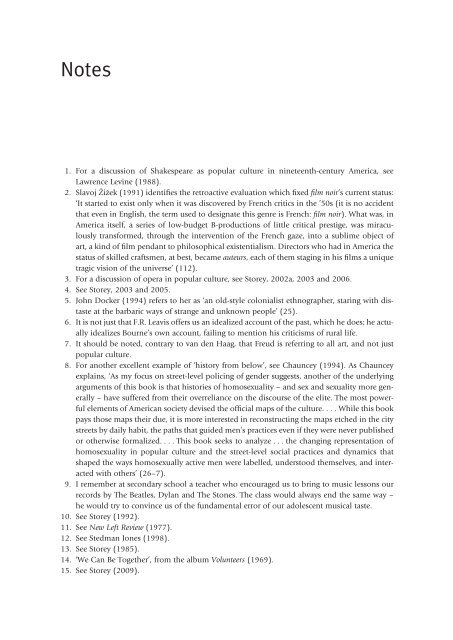Cultural Theory and Popular Culture
Cultural Theory and Popular Culture
Cultural Theory and Popular Culture
Create successful ePaper yourself
Turn your PDF publications into a flip-book with our unique Google optimized e-Paper software.
Notes<br />
1. For a discussion of Shakespeare as popular culture in nineteenth-century America, see<br />
Lawrence Levine (1988).<br />
2. Slavoj yizek (1991) identifies the retroactive evaluation which fixed film noir’s current status:<br />
‘It started to exist only when it was discovered by French critics in the ’50s (it is no accident<br />
that even in English, the term used to designate this genre is French: film noir). What was, in<br />
America itself, a series of low-budget B-productions of little critical prestige, was miraculously<br />
transformed, through the intervention of the French gaze, into a sublime object of<br />
art, a kind of film pendant to philosophical existentialism. Directors who had in America the<br />
status of skilled craftsmen, at best, became auteurs, each of them staging in his films a unique<br />
tragic vision of the universe’ (112).<br />
3. For a discussion of opera in popular culture, see Storey, 2002a, 2003 <strong>and</strong> 2006.<br />
4. See Storey, 2003 <strong>and</strong> 2005.<br />
5. John Docker (1994) refers to her as ‘an old-style colonialist ethnographer, staring with distaste<br />
at the barbaric ways of strange <strong>and</strong> unknown people’ (25).<br />
6. It is not just that F.R. Leavis offers us an idealized account of the past, which he does; he actually<br />
idealizes Bourne’s own account, failing to mention his criticisms of rural life.<br />
7. It should be noted, contrary to van den Haag, that Freud is referring to all art, <strong>and</strong> not just<br />
popular culture.<br />
8. For another excellent example of ‘history from below’, see Chauncey (1994). As Chauncey<br />
explains, ‘As my focus on street-level policing of gender suggests, another of the underlying<br />
arguments of this book is that histories of homosexuality – <strong>and</strong> sex <strong>and</strong> sexuality more generally<br />
– have suffered from their overreliance on the discourse of the elite. The most powerful<br />
elements of American society devised the official maps of the culture. . . . While this book<br />
pays those maps their due, it is more interested in reconstructing the maps etched in the city<br />
streets by daily habit, the paths that guided men’s practices even if they were never published<br />
or otherwise formalized. . . . This book seeks to analyze . . . the changing representation of<br />
homosexuality in popular culture <strong>and</strong> the street-level social practices <strong>and</strong> dynamics that<br />
shaped the ways homosexually active men were labelled, understood themselves, <strong>and</strong> interacted<br />
with others’ (26–7).<br />
9. I remember at secondary school a teacher who encouraged us to bring to music lessons our<br />
records by The Beatles, Dylan <strong>and</strong> The Stones. The class would always end the same way –<br />
he would try to convince us of the fundamental error of our adolescent musical taste.<br />
10. See Storey (1992).<br />
11. See New Left Review (1977).<br />
12. See Stedman Jones (1998).<br />
13. See Storey (1985).<br />
14. ‘We Can Be Together’, from the album Volunteers (1969).<br />
15. See Storey (2009).
















